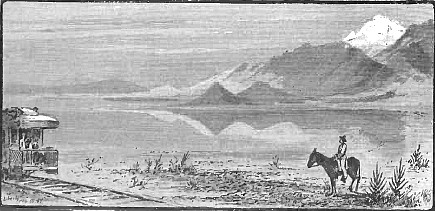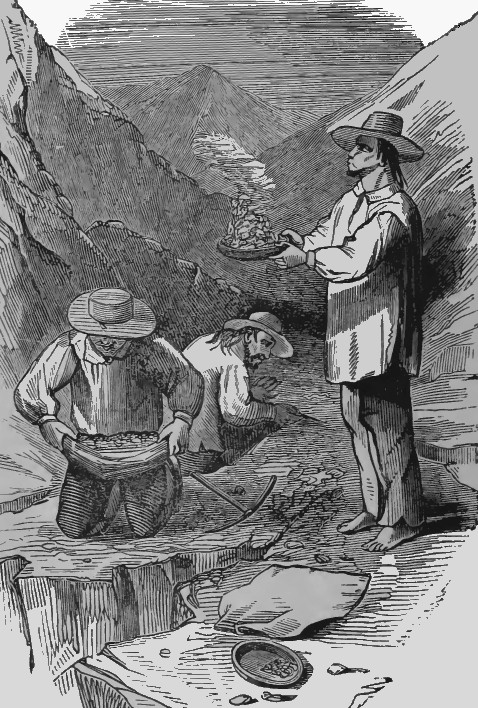Yavapai County is nearly co-extensive with the great Colorado Plateau, and is the largest county in Arizona, being more than one-fourth of the whole Territory. It covers an area of over 30,000 square miles. It was one of the four counties into which Arizona was divided by the first legislature in 1864, and originally included the whole of Apache county and part of Maricopa and Gila counties. Its present boundaries are Maricopa and Gila counties on the south, Yuma and Mohave on the west, Utah on the north and Apache County on the east. It is an immense table land, intersected by ranges of mountains, such as the San Francisco, the Bill Williams, the Sierra Prieta, the Black Hills and the Bradshaw ranges, while between these the face of the country is diversified by beautiful valleys and rich plains, while here and there deep canons and rocky gorges occur. The County is well watered, having, among its rivers, the Verde, the Little Colorado, Hassayampa, Agua Fria, Kirkland Creek, Santa Maria and any number of smaller streams that pour down the rocky sides of the mountain ranges, drawing their supply of clear cold water from the snow-covered peaks where they take their rise. The plains and valleys are admirably suited for farming and stock-raising, and timber is plentiful and of excellent quality.
The County, owing partly to its vast extent and partly to the rugged nature of portions of the ground that has to be traversed, has only been partially explored, and it is believed that only a tithe if so much of its resources is known. Gold was first discovered by prospectors from New Mexico in 1863, and the same year witnessed the famous "find" by Californian prospectors at Antelope Peak) and a rush of miners and prospective settlers into the country was the result. The blood-thirsty Apaches, however, here as elsewhere, acted as an effective check on the development of the country by their raids, and it was not until their final settlement on reservations, by General Crook, that anything like substantial and permanent progress was made. Since that time, however, the County has made wonderful strides. As a matter of fact no other portion of the Southwest has secured so large and so desirable an increase in its population during the last few years as has Central Arizona. While there are isolated instances of a few sections having, under the ephemeral excitement of a "gold rush boom," attracted, for the time being, more attention, the growth of this portion of Arizona has been a steady one, permanent and stable in its character, and entirely free from the feverish intoxication of speculation which so often forms the only basis on which new regions of the West are brought into prominence to be maintained there until the schemes of unscrupulous speculators are consummated and then allowed by their "boomers" to relapse into their former obscurity.
To present by means of the pen alone, a satisfactory idea of any frontier settlement is a most difficult matter. The causes that have called such settlement into existence may be narrated, while its growth may be explicitly set forth with the utmost conscientious observance of statistical minutise, and yet the impression so created may be far from being in the slightest degree correct. To state that within less than a quarter of a century more people have found homes within a radius of a hundred miles of Prescott, than were planted along the entire Atlantic Coast of North America during the first half of a century following the landing of the Pilgrim Fathers, is merely setting forth a threadbare fact that may attract but little attention from the great mass of readers, although it is weighty with meaning to those disposed to read between the lines. To them it tells of privations and hardships ; of death brought by sickness and savages, oftentimes without the voice of a single being to break the silence with words of cheer or consolation in the last struggle. But those days are gone forever, so why revert to them? Let us rather view the present and its prosperous homes in this but recently reclaimed wilderness.
Prescott, the county seat of Yavapai County, one of the largest counties in the Union, has the honor of being the pioneer "American " settlement in the entire Southwest. While many of the citizens of the United States had, years before, found their way into Arizona and New Mexico, they had been always satisfied to accept the situation as they found it, and contented themselves with being identified with the interests of the old Spanish settlements. So fixed had this come to be the custom, that the commissions of the first civil appointees to whom was entrusted the management of the public affairs of the new Territory, designated Tucson as the Territorial Capital. Disregarding this, however, the gubernatorial party struck boldly out from Albuquerque to establish the Territorial Capital in Central instead of Southern Arizona. The reasons for doing so were manifold. The advantages in climate, accessibility and resources were all in favor of the new site as against Tucson, while the then recent discovery of rich and extensive placer gold mines on Lynx Creek may have strengthened the views of the party in this regard, by creating a natural desire to be so located as to be able to reap a share in the general prosperity brought by the newly-discovered " bonanzas." The first and only halt made by the official party and its escorts, was at Chino Valley, twenty miles north of Prescott, from which point reconnoitering parties were sent out to discover the best site for a city, and the grounds now occupied by Prescott was, after much searching, finally selected. The wisdom of this selection future years will more forcibly demonstrate than the past has done. Built on a small table of the Sierra Prieta mountain range, the first sight of the city is one which commands at once the attention and admiration of the most unobservant. Far to the north, through the vista of the Red Buttes, through which Granite Creek has cut its channel, is seen the peak of the San Francisco Mountains, looming up like some great and silent sentinel set to watch over the destiny of the land until time itself shall be lost in eternity.
To the south, Mount Union towers into the clouds like some warden of old, watching and waiting to see what this restless race, which has pierced its mountain sides with shaft and tunnel, shall bring to the land, in which, but a few years ago, reigned a solitude unbroken save by the savage. To the west, like an enormous Sphinx, sleepily watching the rush and rustle of the new order of things, is seen Thumb Buttes; while its stern vis-a-vis, Granite Mountain, with its great coffin-shaped outline, seems as if created solely to serve, like the mummy of the Egyptian roysterers, to remind man that "all is vanity," and that to "eat, drink and be merry," gain riches or win fame, means to man, after all, naught but to die and to be forgotten. To the east of the city, bear away, in the dim distance, rolling hill?, on whose grass-covered sides thousands of cattle graze ; while, through the center of the town, dividing it into East and West Prescott, flow the placid waters of Granite Creek. The city is distinctly American. Nowhere is there to be found the flat roof, prison-like structures of sun-dried adobe, so common elsewhere in the Southwest. The buildings dwelling and business are all of lumber or brick.
The city is built around a public plaza, in the center of which has been erected, at the cost of over a hundred thousand dollars, the County Courthouse, which is admitted to be the finest public structure in either New Mexico or Arizona. Facing the plaza are the principal business houses, many of which, in size and style surpass those of older and more pretentious communities. One block east of the Courthouse stands the City Hall on what is known as " Nob Hill." The building is of brick, and is two stories in height, together with a basement and an attic. It stands on a spur of one of the surrounding mountains, and, from its windows, magnificent views of the surrounding country may be had for miles in every direction. To the east of the City Hall and on the same street, is the public school building, the largest in the Territory, and capable of accommodating nearly 500 pupils. The services of five teachers are required throughout the year, so large is the attendance, while the course of instruction ranges from " A B C " to the ancient languages, higher mathematics, etc. The city is well supplied with water, having a magnificent system of public water works which cost $100,000, with water mains traversing all the streets, which latter are laid out with as strict regard for the cardinal points of the compass as are those of the "City of magnificent distances" itself.
Its numerous churches, erected and maintained by the Catholics, Methodists, Episcopalians, Methodist South, Baptists and Congregationalists, speak of somewhat closer attention to religious affairs than is usually expected on the frontier. Each of the denominations named have a neat edifice to worship in, while Far Cathay has built its place in the shape of a "Joss-house," glorious in tinsel and Tartar-featured Rods, some in effigy and some painted on silk. In the way of fraternal societies, the Masons, Odd Fellows, Knights of Pythias, Grand Army of the Republic, the Order of the Eastern Star, are all well represented by large-sized Lodges. Organizations of a more public character are represented by a well-uniformed and equipped Volunteer Fire Department, and a company of the National Guard of Arizona.
Among its business enterprises, Prescott numbers two daily newspapers the Journal-Miner, edited by J. C. Martin, and the Courier, by J. H. Marion each of which possesses a large circulation and are always newsy and interesting. The city has, besides its complement of business houses usual to any city of two thousand inhabitants, three hotels, a bank, a brewery, two furniture establishments, and fine sampling works, Commercially considered, the city is the base of supplies of an immense tract of rapidly-developing country. As all roads led to Rome in the " brave days of old," so here all roads lead to Prescott, and the advent of the Prescott and Arizona Central Railway is a sufficient guarantee that its supremacy in this respect will be maintained. The future of this road is one worthy of the enterprise and intelligence that has heretofore been identified with its destinies. From Prescott its extension south (on which work will be resumed the approaching summer) lies through many of the richest mining districts in the Union for over a hundred miles, when- it enters the rich agricultural valleys of the Salt and Gila rivers, to finally find a southern terminus on the Gulf of California, while on the north it eventually will be extended through Utah into the mining regions of the Northern States, making it, in effect, the great railroad system of the backbone of the continent. There are many prominent and enterprising business houses located in Prescott.
Return
to The Arizona Page:
Arizona Gold Rush Mining History



